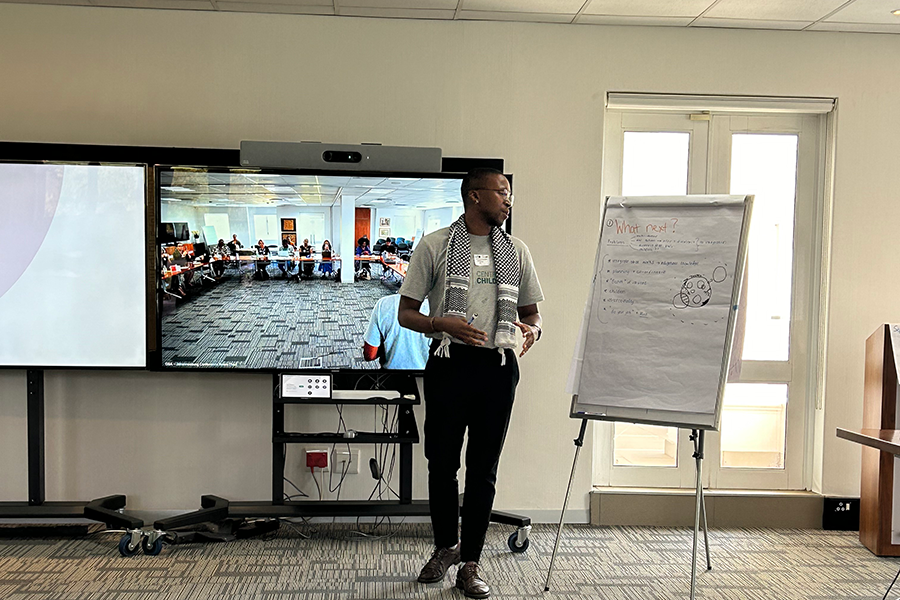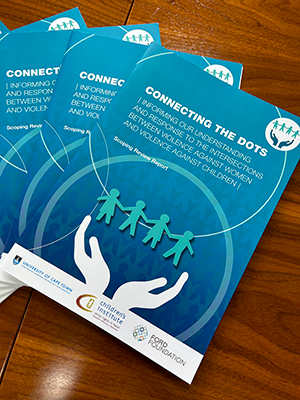
Written by Athraa Fakier, February 2024
On 30 November 2023, stakeholders convened at The Ford Foundation in Melrose Estate, Johannesburg, for a pivotal roundtable dialogue on the complex intersections of violence against women (VAW) and violence against children (VAC). This gathering of eminent voices within the women and children's sectors presented a significant learning opportunity in the ongoing pursuit of sharing knowledge and experiences across the two sectors. Professor Shanaaz Mathews opened the dialogue with an overview of the state of evidence on the intersections of VAW and VAC. This was followed by presentation on the Closing the Gaps research and an examination of the evolving funding landscape. The event highlighted a continued and resolute dedication to effecting tangible change.
Closing the gaps:

Lucy Jamieson (Children’s Institute) and Sibongile Vutu (Masimanyane) presented an overview of the findings from Closing the Gaps, an exploratory study on service provision for violence against women and children in two rural communities of Eastern Cape, South Africa (Buffalo City and Gcuwa). The study aimed to understand how services in these two communities are delivered and to start a dialogue on what is required to deliver culturally appropriate services for women and children.
Key points that arose from the desktop research were that children are aware of violence in their surroundings and have the ability to articulate their encounters and the kind of support they need (Titi, 2021). However, service providers frequently fail to acknowledge the link between the mother's experiences and that of their children as co-victims, resulting in fragmented service delivery (Nagia-Luddy & Mathews, 2011). There is also increasing evidence of the interconnections of intimate partner violence (IPV) and violence against children (VAC), as they share the same drivers, co-occur in the same households, and drive an intergenerational cycle of violence (Mathews et al., 2021). Both IPV and VAC lead to similar health outcomes, including psychological effects that influence the intergenerational impact of violence through the shaping of gendered social norms that drive violence (Jamieson et al., 2018). Whilst women need services to support their own recovery, work through their trauma and regain their independence, many women enter shelters with their children during this process (Watson & Lopes, 2017). As such, their children are likely to have been exposed to or experienced violence in the home, which in turn increases children’s risk for violence perpetration and victimisation later in life (Fulu et al., 2017). Thus, both women and children in this context need support to recover and heal.
South Africa has a dual legal system. In communities where customary law is practiced, the family is the starting point to address “domestic” issues. Family meetings are convened to resolve complaints about violence in the home, all family members have a right to be heard in these discussions, but the concerns of women and children are frequently dismissed. Furthermore, preserving family unity often takes precedence over justice. When matters are escalated to traditional courts, women must be accompanied by a male family member and follow strict protocols about dress and behaviour. These courts are dominated by men and there are concerns about patriarchal protocols silencing women and prejudicing outcomes.
The research confirmed that access to professional services poses a significant challenge, due to long distances to reach the nearest police station, and transport limitations in rural areas. Particularly concerning in cases of sexual assault is the difficulty in accessing a TCC (Thuthuzela Care Centre) within the timeframe required for DNA analysis. Furthermore, since English serves as the language of record in the courts, police statements provided by victims are translated from their mother tongue, often resulting in misinterpretations or loss of nuanced information. Despite isiXhosa being one of South Africa’s official languages, all proceedings, including court sessions, are conducted in English, which exacerbates the issue. This language barrier contributes to the ineffectiveness of protection orders, particularly for women in rural areas, as authorities often fail to adequately explain the terms and consequences of the order to both the victim and perpetrator, undermining its intended purpose.
Hence, there arises a necessity for a comprehensive suite of services that not only enhances women's and children's access to justice but also attends to their distinct needs, aiming to prevent further victimization and dismantle the intergenerational cycle of violence. Language plays a crucial role in both accessing and delivering services. It is central to African people’s self-definitions and plays a key role in conveying the meaning of experiences (Titi, 2021).
Funding landscape

To provide some context around service provision, Carmen Abdoll from Cornerstone spoke about the funding landscape and how this has influenced service delivery. In 2023 the Department of Social Development (DSD) released a new Sector Funding Policy (SFP). This policy serves as a standard for how provincial DSDs (PDSDs) fund services provided by partners in the NPO sector. It sets out which services will be funded and how much will be allocated for specific services. The SFP recommends that all provincial Departments of Social Development ring fence a minimum of 5% of their total budget for prevention programmes. There are four priority areas for this investment: parenting programmes; intimate partner violence; substance abuse; and social crime prevention among young people. DSD programmes are next in the funding hierarchy and then NPOs with existing TPAs in order of priority determined in the policy. However, primary prevention is not well understood, and evidence of what works in the Global South, in particular the African context needs to be shared with implementing partners. As one participant mentioned: “Funding causes division. We’re pitting services against one another” when we need to be fostering collaboration and cooperation.
What came out of the plenary
The plenary discussion underscored two important points: firstly, the need for collaboration resonated strongly, advocating for a unified effort from both women’s and children’s sectors, as well as the necessity of adopting a dual-system approach, integrating indigenous and traditional systems alongside civil structures. Secondly, emphasis was placed on the importance of identifying shared objectives or initiatives for collaboration. While research provides clear insights into what is needed to address violence against women and children, there's a need to articulate compelling arguments to garner support from key stakeholders, spanning government entities and civil society organizations.
